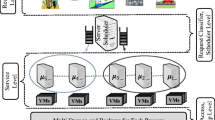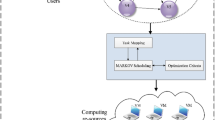Abstract
In the era of adopting Internet everywhere, the recent modernization through incredible Internet of Things (IoT) makes the world more shrewd and automated. Thousands of users are connected every day in order to get benefits from the promising IoT solutions. Subsequently, a colossal amount of requests demanding different types of services for different IoT eco-system applications are very frequent. This creates a big challenge to the IoT service providers because IoT has a limited resources for storing and processing of huge data generating every second. Therefore, managing these resources while maintaining a good service quality is also an obvious challenge for the service provider as the ultimate goal is to satisfy user expectations. In this context, to abolish the restraints of IoT, it is, no doubt, a perceptive idea to fuse the powerful data analysis technique (data mining) with the compelling data management technique (cloud computing). Our paper proposes an Incremental Scheduling of Correlated IoT Requests (ISCIR) mechanism that makes a novel attempt to resolve the problem of scheduling massive IoT requests. It allocates adequate resources to the requests through cloud computing and data mining techniques while assuring a better service quality to the IoT application users. A monitoring system is used to collect the relevant data about the service requests and an appropriate information extraction process is used to get the useful patterns from the collected data. Thus, an incremental scheduling approach is proposed which enhances the knowledge about the system in its each iteration and uses that knowledge for managing the resources. An analytical analysis of the proposed approach considering the heterogeneity of IoT requests is derived. Finally, the simulation is done to validate the analytical analysis and the results show significant improvement in the performance of the system based on some prominent Quality of Service (QoS) parameters.

























Similar content being viewed by others
References
Gubbi, J., et al. (2013). Internet of Things (IoT): A vision, architectural elements, and future directions. Future Generation Computer Systems, 29(7), 1645–1660.
Whitmore, A., Agarwal, A., & Xu, L. D. (2015). The Internet of Things—A survey of topics and trends. Information Systems Frontiers, 17(2), 261–274.
Bello, O., Zeadally, S., & Badra, M. (2017). Network layer inter-operation of Device-to-Device communication technologies in Internet of Things (IoT). Ad Hoc Networks, 57, 52–62.
Zhou, H. (2012). The internet of things in the cloud: A middleware perspective. Boca Raton: CRC Press.
Flávia, Coimbra D., Pires, P. F., & Batista, T. (2017). Resource management for Internet of Things. Springer Briefs in Computer Science, 1–112.
Al-Fagih, A. E., et al. (2013). A priced public sensing framework for heterogeneous IoT architectures. IEEE Transactions on Emerging Topics in Computing, 1(1), 133–147.
Li, S., et al. (2012). Integration of hybrid wireless networks in cloud services oriented enterprise information systems. Enterprise Information Systems, 6(2), 165–187.
Liu, M., et al. (2008). Performance analysis and optimization of handoff algorithms in heterogeneous wireless networks. IEEE Transactions on Mobile Computing, 7(7), 846–857.
Li, L., Li, S., & Zhao, S. (2014). QoS-aware scheduling of services-oriented internet of things. IEEE Transactions on Industrial Informatics, 10(2), 1497–1505.
Abdullah, S., & Yang, K. (2013). An energy-efficient message scheduling algorithm in Internet of Things environment. In IEEE 2013 9th international wireless communications and mobile computing conference (IWCMC).
Kuo, Y.-W., & Chou, L.-D. (2015). Power saving scheduling scheme for Internet of Things over LTE/LTE-advanced networks. Mobile Information Systems, 2015, 971538.
Edemacu, K., & Bulega, T. (2014) Resource sharing between M2M and H2H traffic under time-controlled scheduling scheme in LTE networks. In IEEE 2014 8th international conference on telecommunication systems services and applications (TSSA).
Bharti, S., & Pattanaik, K. K. (2016). Task requirement aware pre-processing and Scheduling for IoT sensory environments. Ad Hoc Networks, 50, 102–114.
Leu, J.-S., Chen, C.-F., & Hsu, K.-C. (2014). Improving heterogeneous SOA-based IoT message stability by shortest processing time scheduling. IEEE Transactions on Services Computing, 7(4), 575–585.
Narman, H. S., et al. (2017). Scheduling internet of things applications in cloud computing. Annals of Telecommunications, 72(1–2), 79–93.
TongKe, F. (2013). Smart agriculture based on cloud computing and IOT. Journal of Convergence Information Technology, 8(2).
Sharma, R., et al. (2015). Probabilistic prediction based scheduling for delay sensitive traffic in Internet of Things. Procedia Computer Science, 52, 90–97.
Gross, D. (2008). Fundamentals of queueing theory. New York: Wiley.
Adan, I., & Resing, J. (2002). Queueing theory. Department of Mathematics and Computing Science, Eindhoven University of Technology, The Netherlands. http://www.win.tue.nl/_iadan/queueing.pdf.
White, G., Nallur, V., & Clarke, S. (2017). Quality of service approaches in IoT: A systematic mapping. Journal of Systems and Software, 132, 186–203.
Moschakis, I. A., & Karatza, H. D. (2015). Towards scheduling for Internet-of-Things applications on clouds: A simulated annealing approach. Concurrency and Computation: Practice and Experience, 27(8), 1886–1899.
Singh, A., & Viniotis, Y. (2017). Resource allocation for IoT applications in cloud environments. In IEEE 2017 international conference on computing, networking and communications (ICNC).
Li, W.-X., Xu, J., & Jiang, H. (2012). Queuing states analysis on a hybrid scheduling strategies for heterogeneous traffics in IOT. In IEEE 2012 international conference on computer science & service system (CSSS).
Abdullah, S., & Yang, K. (2014). An energy efficient message scheduling algorithm considering node failure in IoT environment. Wireless Personal Communications, 79(3), 1815–1835.
Chen, H., & Li, S. (2010). A queueing-based model for performance management on cloud. In 2010 6th international conference on IEEE advanced information management and service (IMS).
Goswami, V., Patra, S. S., & Mund, G. B. (2012). Performance analysis of cloud with queue-dependent virtual machines. In IEEE 2012 1st international conference on recent advances in information technology (RAIT).
Xiong, K., & Perros, H. (2009) Service performance and analysis in cloud computing. In IEEE 2009 world conference on services-I.
Loo, K. K., Tong, I., Kao, B., & Chenung, D. (2005). Online algorithms for mining inter-stream associations from large sensor networks. In Proceedings of ninth Pacific-Asia Conference on knowledge discovery and data mining (PAKDD ’05).
Romer, K. (2006). Distributed mining of spatio–temporal event patterns in sensor networks. EAWMS/DCOSS, 1(1), 103–116.
Rashid, Md M., Gondal, I., & Kamruzzaman, J. (2014). A novel algorithm for mining behavioral patterns from wireless sensor networks. In International joint conference on neural networks (IJCNN), 2014. IEEE, 3713–3719.
Boukerche, A., & Samarah, S. (2008). A novel algorithm for mining association rules in wireless ad hoc sensor networks. IEEE Transactions on Parallel and Distributed Systems, 19(7), 865–877.
Hastie, T., Tibshirani, R., & Friedman, J. (2002). The elements of statistical learning: Data mining, inference, and prediction. Biometrics.
Alves, F. S. Q., et al. (2011). Upper bounds on performance measures of heterogeneous M/M/c queues. Mathematical Problems in Engineering. https://doi.org/10.1155/2011/702834.
“Mushroom dataset” Frequent itemset mining dataset repository. http://mi.ua.ac.be/data.
“c20d10k” The Coron System Coron.loria.fr. http://coron.loria.fr/sitedownloadsdatasets.php
Hu, Y., et al. (2009). Resource provisioning for cloud computing. In Proceedings of the 2009 conference of the center for advanced studies on collaborative research. IBM Corp.
Author information
Authors and Affiliations
Corresponding author
Additional information
Publisher's Note
Springer Nature remains neutral with regard to jurisdictional claims in published maps and institutional affiliations.
Rights and permissions
About this article
Cite this article
Chowdhury, A., Raut, S. Scheduling Correlated IoT Application Requests Within IoT Eco-System: An Incremental Cloud Oriented Approach. Wireless Pers Commun 108, 1275–1310 (2019). https://doi.org/10.1007/s11277-019-06469-w
Published:
Issue Date:
DOI: https://doi.org/10.1007/s11277-019-06469-w




